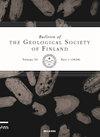1.88 Ga granitoids at Sorsakoski, Central Finland: A-type magmatism within the Raahe-Ladoga suture zone
IF 1.3
4区 地球科学
Q2 GEOLOGY
引用次数: 0
Abstract
Four quartz monzonite – granite intrusions forming the Sorsakoski granite lithodeme, are found within the Raahe-Ladoga suture zone in Central Finland. The prevailing potassium feldspar megacrystic quartz monzonites and granites form a bimodal association with diorites and gabbros. The granitoids are mainly calc-alkaline, ferroan, per- to metaluminous, and have high Zr and REE contents. Dominant mafic minerals are biotite and hornblende, clinopyroxene and orthopyroxene are locally present. The mafic units display effects of fractionation of clinopyroxene. In our interpretation, these intrusions were emplaced during regional late stages of deformation and post-crystallisation deformation partitioned into major shear zones leaving bulk of the intrusions relatively undeformed. Based on one new (1876 ± 6 Ma) and one pre-existing (1882 ± 5 Ma) U-Pb zircon age determination, the crystallisation age of the granitoids can be assumed at ca. 1880 Ma. Based on mineralogy, petrography, geochemistry, bimodal nature of magmatism and age, we correlate these intrusions to the A-type rocks of the previously described Saarijärvi suite. This shows that the syn-orogenic A-type magmatism extended eastwards beyond the Central Finland Granitoid Complex.芬兰中部索萨科斯基的 1.88 Ga 花岗岩:Raahe-Ladoga缝合带内的A型岩浆活动
在芬兰中部的拉赫-拉多加缝合带中发现了四个石英单斜岩-花岗岩侵入体,形成了索萨科斯基花岗岩岩系。主要的钾长石巨晶石英单长岩和花岗岩与闪长岩和辉长岩形成双峰组合。花岗岩主要为钙碱性、铁质、过铝质到金属铝质,锆和稀土元素含量较高。主要的黑云母矿物是黑云母和角闪石,局部存在霞石和正长石。黑云母单元显示了霞石的分馏效应。根据我们的解释,这些侵入体是在区域变形晚期阶段形成的,结晶后变形分为主要剪切带,侵入体的大部分相对未变形。根据一次新的(1876 ± 6 Ma)和一次已有的(1882 ± 5 Ma)U-Pb锆石年龄测定,花岗岩的结晶年龄可推定为约1880 Ma。1880 Ma。根据矿物学、岩相学、地球化学、岩浆作用的双峰性质和年龄,我们将这些侵入体与之前描述的 Saarijärvi 岩石群的 A 型岩石相关联。这表明,同步成因的 A 型岩浆活动向东延伸到了芬兰中部花岗岩群之外。
本文章由计算机程序翻译,如有差异,请以英文原文为准。
求助全文
约1分钟内获得全文
求助全文
来源期刊
CiteScore
1.30
自引率
0.00%
发文量
5
审稿时长
>12 weeks
期刊介绍:
Bulletin of the Geological Society of Finland (BGSF) publishes research articles and short communications in all branches of geosciences. Contributions from outside Finland are welcome, provided that they contain material relevant to Finnish geology or are of general interest.

 求助内容:
求助内容: 应助结果提醒方式:
应助结果提醒方式:


